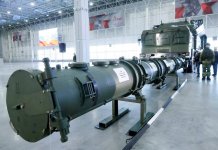India is set to acquire MQ-9 Reaper drones from the US in view of the ongoing border standoff with China. The US Air Force recently demonstrated and tested the advanced capabilities of this drone.
Earlier this year, the Indian armed forces had approached the Defense Ministry for the procurement of 30 armed MQ-9 Reaper drones, 10 each for the Army, Navy, and the Air Force.
The procurement is being done to counter the Chinese combat drones, the Wing Loong II. The drone manufactured by China’s Chengdu Aircraft Corporation has reportedly been acquired by Pakistan and is set to be produced jointly by the two countries in the future.
Last year, the Indian Navy had procured two MQ-9B drones on lease to carry out surveillance operations in the Indian Ocean. These drones began their operational role from the Indian Navy’s INS Rajali in November 2020.
The @IndianNavy has leased 2 U.S. MQ-9B SeaGuardian reconnaissance drones, part of an active effort to least/purchase a larger number of an armed version. We'll have a detailed report up later. pic.twitter.com/9XecE1VO8f
— Livefist (@livefist) November 25, 2020
It seems that the Indian military, especially the Navy, was satisfied with the performance of the US drones. The Navy believes that the acquisition of the drones will enhance its capabilities to monitor Chinese warships in the southern Indian Ocean while helping the army to manage the targets along the Indian borders.
The MQ-9
Manufactured by General Atomics, the initial MQ-1 was called Predator. In 2018, the US Air Force switched from its use of the MQ-1 Predator to the MQ-9A Reaper drones.
The MQ-9A was designated ‘Reaper’ by the US and UK Royal Air Force. It has an endurance of over 27 hours and can operate up to an altitude of 50,000 feet. The payload capacity is around 3,850 pounds which also includes 3,000 pounds of external stores.
The UAV is equipped with a fault-tolerant flight control system and triple-redundant avionics system architecture. It is powered by a flight-certified and proven Honeywell TPE331-10 turboprop engine, which is combined with Digital Electronic Engine Control (DEEC), which enhances engine performance and fuel efficiency, especially at low altitudes.
The highly modular system can be configured with a variety of payloads at ease. It is capable of carrying out various mission payloads such as – Electro-optical/Infrared (EO/IR), Lynx Multi-mode Radar, multi-mode maritime surveillance radar, Electronic Support Measures (ESM), laser designators and other weapons and payload packages.

A variant of the MQ-9A Reaper, optimized for maritime missions is known as the MQ-9B SeaGuardian. The MQ-9B comprises both hardware and software upgrades, like improved structural fatigue and damage tolerance, flight control software, enhancements to function in adverse weather conditions, along with protection against bird and lightning strikes.
The drone can carry up to four Hellfire II anti-armor missiles and two laser-guided bombs (GBU-12 or EGBU- 12) and 500 lb GBU-38 JDAM (joint direct attack munition).
The SeaGuardian can be configured with various payloads. It is equipped with Detect and Avoid (DAA) system and can be configured with cross-domain capabilities to conduct maritime surveillance operations, such as Anti-Surface Warfare (ASuW), Anti-Submarine Warfare (ASW), Humanitarian Assistance/Disaster Relief (HA/DR), Search and Rescue and Oceanic Maritime Security Initiative (OMSI).
The Latest Tests
The MQ-9 drone is going through constant upgrades, and it seems that soon, the drone can be deployed and operated from a range of locations without developing any specific infrastructure.
According to reports, two successful demonstrations of the MQ-9’s Automatic Take-off and Landing Capability (ALTC) were conducted by the 556th Test and Evaluation Squadron (TES) at Creech Air Force Base in Nevada on July 8, 2021.
A press release by the US Air Force mentions that the ALTC will enable the crews to “divert to airfields without traditional launch and recovery infrastructure or personnel”. In the demonstration, the MQ-9 was operated by the aircrew located at Nellis Air Force Base, via satellites.

On the first day of the demonstration, the TES operated the MQ-9 from Creech AFB to Cannon AFB, New Mexico, by using the imagery in the cockpit to provide the reference points for the automated landing system.
The second day of the tests saw the MQ-9 being operated from the Creech AFB to Holloman AFB, New Mexico, by using the targeting pod.
According to the USAF, the ALTC combined with the expected software upgrade and portable aircraft control station may alter the ways in which it will be employed around the world in the future.
Until now, the MQ-9 has seen split operations, that is, one crew operates the aircraft from the ground station, and another launched and recovered the drone in-theater once it came within line of sight and was “handed off”.
The recovery personnel was also charged with electronically marking reference points on runways using an actual reaper. The Drive mentions that this system barred the drone from self-deploying to an airstrip, where the data had not been gathered and did not possess any supporting infrastructure.
However, after the latest tests, the MQ-9 will be capable of landing at various airfields and installations without requiring predetermined reference points.
Also, it seems that the aircraft may be operated by only one flight crew, using the new ALTC system through which the MQ-9 will be able to land and launch on its own without the assistance of a dedicated ground launch and recovery crew.
The USAF has also mentioned that the aircraft can be diverted “to a foreign field where an MQ-9 has never been before”. This implies that the MQ-9 can be used effectively in emergencies or contingency operations.
This may also enable the MQ-9 to operate from a forward arming and refueling point (FARP), which may be extremely useful in situations where the system is being deployed to cover a large maritime region, such as the Pacific.
India, China ‘Key Contenders’ To Acquire Russia’s F-35 Stealth Fighter Jet – ‘Checkmate’
The USAF has shown keen interest in integrating the MQ-9 into operations involving the Agile Combat Employment (ACE) concept. This may enable the deployment of the MQ-9 to forward locations, as well as remote or difficult sites with adverse conditions.
This will reduce the dependence on operations confined to known or established bases ensuring greater “agility, deterrence, and resiliency in a contested or degraded environment”.




